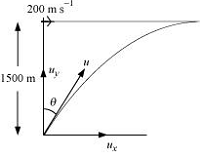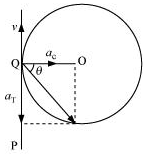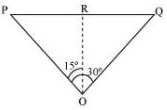Motion in A Plane - Online Test
The cricketer will only be able to throw the ball to the maximum horizontal distance when the angle of projection is 45°, i.e., θ = 45°.
The horizontal range for a projection velocity v, is given by the relation:
R =( u2 Sin 2θ / g)
100 =
=> = 100 ….(i)
The ball will achieve the maximum height when it is thrown vertically upward. For such motion, the final velocity v is zero at the maximum height H.
Acceleration, a = –g
Using the third equation of motion:
v2 – u2 = -2gH
Number of revolutions = 14
Time taken = 25 s
Frequency,
Angular frequency,
=
Centripetal acceleration, ac = ω2r
=
= 9.9 ms-2
The direction of centripetal acceleration is always directed along the string, towards the centre, at all points.
Radius of the loop, r = 1 km = 1000 m
Speed of the aircraft, v = 900 km/h
=
Centripetal acceleration,
=
Acceleration due to gravity, g = 9.8 m/s2
= 6.4 g
Position vector
We know velocity is given by
So
Acceleration is given by
So,
A particle starts from the origin at t = 0 s with a velocity of 10.0 m/s and moves in the x-y plane with a constant acceleration of ( 8.0+ 2.0) m . At what time is the x- coordinate of the particle 16 m? What is the y-coordinate of the particle at that time?
u = uxi + uyj = 10j,
ux = 0 and uy = 10 m/s
a = axi + ayj = 8i + 2j,
ax = 8 and ay = 2 m/s2
x = uxt +axt2
=> 16 =
t = 2 sec
y = uyt + = 10x2 + = 24 m
The positions of the observer and the aircraft are shown in the given figure.
Height of the aircraft from ground, OR = 3400 m
Angle subtended between the positions, ∠POQ = 30°
Time = 10 s
In ΔPRO:
tan 15° =
PR = OR tan 15°
=
ΔPRO is similar to ΔRQO.
∴PR = RQ
PQ = PR + RQ
= 2PR = 2 × 3400 tan 15°
= 6800 × 0.268 = 1822.4 m
∴ Speed of the aircraft =
= 182.24 m/s m/s
A fighter plane flying horizontally at an altitude of 1.5 km with speed 720 km/h passes directly overhead an anti-aircraft gun. At what angle from the vertical should the gun be fired for the shell with muzzle speed 600 m to hit the plane? At what minimum altitude should the pilot fly the plane to avoid being hit ? (Take g = 10 m).
Height of the fighter plane = 1.5 km = 1500 m
Speed of the fighter plane, v = 720 km/h = 200 m/s
Let θ be the angle with the vertical so that the shell hits the plane. The situation is shown in the given figure.

Muzzle velocity of the gun, u = 600 m/s
Time taken by the shell to hit the plane = t
Horizontal distance travelled by the shell = uxt
Distance travelled by the plane = vt
The shell hits the plane. Hence, these two distances must be equal.
uxt = vt
u Sin θ = v
Sin θ =
θ = Sin-1(0.33) = 19.50
In order to avoid being hit by the shell, the pilot must fly the plane at an altitude (H) higher than the maximum height achieved by the shell.
∴ H =
=
= 16006.482 m
≈ 16 km
Speed of the cyclist, v = 27 km/h = 7.5 m/s
Radius of the circular turn, r = 80 m
Centripetal acceleration is given as:
ac = 0.7 ms-2
The situation is shown in the given figure:

Suppose the cyclist begins cycling from point P and moves toward point Q. At point Q, he applies the breaks and decelerates the speed of the bicycle by 0.5 m/s2.
This acceleration is along the tangent at Q and opposite to the direction of motion of the cyclist.
Since the angle between ac and aT is 900, the resultant acceleration a is given by:
a =
= = 0.86 ms-2
tan θ =
where θ is the angle of the resultant with the direction of velocity.
tan θ = = 1.4
θ = tan-1(1.4) = 54.56° with the direction of velocity
A ball is thrown upwards with an initial velocity of 10 m . Determine the maximum height reached above the thrower’s hand. Determine the time it takes the ball to reach its maximum height.
Initial velocity u = 10m/s
As at the maximum height ball ll stop so final velocity v = 0 m/s
Only acceleration working on it is acceleration due to gravity g = -9.8m/s2
Let height = h
So we know
=>
=> 5.10 m
Also let time taken to reach maximum height = t
Then
We know
v = u +at
=> 0 = 10 +(-9.8)t
=> t =

